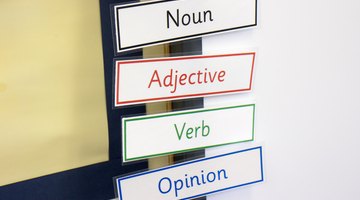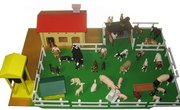Nouns and verbs are both required to create a complete sentence. This makes nouns and verbs a good place to start when introducing parts of speech to your child. Help her gain a solid understanding of sentence structure by clarifying the difference between a noun and a verb, and how the two work together to create the foundation upon which a sentence is built. Learning nouns and verbs does not have to be drudgery if you keep the activities fun and relevant.
Make noun cards. Cut red paper into pieces the size of flash cards. Write the names of household objects, people, pets and other places, such as school, on one side of each card, and the word "noun" on the reverse side of all of the cards.
Prepare your verb cards in the same fashion as you created your noun cards. Use green for your verb cards. Traffic lights use green for "go," so using green cards for action words will make sense to your child.
Explain to your child that nouns are people, places or things. Have your child match the red noun cards with the objects in your house. Next have your child find other nouns in your house that don't have cards, and have him make noun cards for those objects. Continue these activities until he has a solid understanding of what nouns are.
Show your child a simple sentence in print. Explain to her that not all words are nouns, and she'll learn about the others later. Have her use a red pencil to circle the word in the sentence that is a noun. Repeat until she can easily find the noun every time.
Once your child knows what a noun is, explain that a verb is an action word. Save sedentary examples such as "think" for later and start with movement verbs. For example, hand your child a green verb card with "jump" written on it and have him jump up and down. Make a game of it by passing him card after card of verb examples and having him act them out. Use verbs such as "wiggle" or "bark" to make it silly and fun.
Once she has a solid concept of movement verbs, expand the lesson by talking about other verbs such as "read," "think" and "decide." Explain that a verb is simply something that is done by a noun. Have her make more green verb cards for verbs that she thinks of herself.
Show him a sentence in print. Have him find the noun and circle it in red, and then find the verb and circle it in green.
Add meaning to the lesson by telling your child why she needs to know what nouns and verbs are. Explain that a complete sentence must contain both, and that three words such as "the gray cat" do not complete a sentence. Ask her why not, and see if she can figure out that a verb is missing. Have her think of a verb to add, such as "sleeps," to complete the sentence.
Play a sentence game with your child, putting the noun and verb cards in bags and pulling out one of each to make a sentence. Some combinations will be easy, such as "dog" and "sit," but others, such as "shoe" and "sing," will test your child's creativity and make him think more about how to use the parts of speech.
Reinforce the concept by posting cards throughout the house. For example, on the bathroom mirror tape a green card that says "brush" next to a red card that says "teeth." Above the game console in the family room, post a green card that says "take" and a red card that says "turns."
Related Articles
Writer Bio
Nancy Lovering is a writer, photographer and teaching assistant. She took novel writing at Langara College and photography at British Columbia Institute of Technology. She obtained her teaching assistant certificate through Delta School District Continuing Education. She previously worked as an assistant controller while in the Certified General Accountants program, and has training in dog psychology through Custom Canine Teaching Ltd. in Vancouver, BC.











